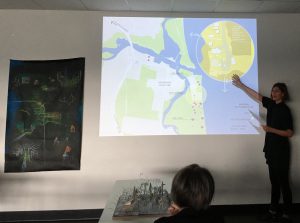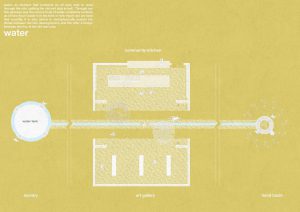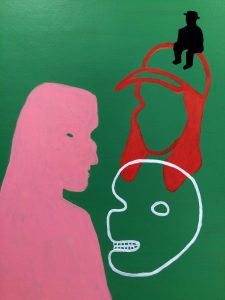Vivid artwork and architecture have intertwined in a Griffith Master of Architecture student’s research project, which aims to “connect people to place without four walls and a pitched roof”.

Nunan presenting her thesis research.
A native of the Byron Bay region, artist Verity Nunan co-authored The Journal of Public Space article ‘What the mapping of Byron Bay Shire’s informal settlement teaches us about having a home without having a house’ with Griffith Architecture and Design Associate Professor Karine Dupre, and based her research thesis on the homeless people of the Byron Bay and Brunswick Heads areas.
“My research is to make more significant and meaningful architecture in the future, but you need the groundwork. Research is a powerful tool for us to truly understand the world around us,” Nunan said.

Nunan created a floorplan to connect homeless and non-homeless people.
“As architects we often want to solve homelessness issues by making houses, which is an important thing to do, but my research has shown that people value other things like routine, symbolism and connection to others as a sense of belonging. So making art and architecture is what references those senses of belonging for people who live in the bush.”
As part of her thesis, Nunan designed a botanical garden through masterplanning and identified the two demographics that needed to be targeted – the homeless and non-homeless, and defined the thresholds where they interacted and where they didn’t.
“I created a corridor for places where they interact and made a botanical garden around it, and implemented different artistic and architectural interventions that encouraged communication,” Nunan said.
“It’s about giving people a platform where they can get to know each other and assume less about each other.”
Nunan’s academic insights and artistic flair were thrust into the spotlight with an unveiling of the artworks inspired by her research work in an exhibition of her bold paintings hosted by Street Gallery at the Byron Bay Community Centre Coffee Box, a non-profit organisation run by and for the homeless.
“I became close to the people in the bush. I wanted to put on a public art exhibition that told a bigger story about Byron Shire – it’s the second highest homeless population outside of Sydney,” Nunan said.

One of the artworks inspired by the research.
“I made outlines and silhouettes and put them on a board as a public artwork for people in the bush to come into town and see them.”
While Nunan awaits the official completion of her Masters, which received some financial research support from the Griffith School of Engineering and Built Environment, the accomplished artist and budding social architect is already planning a new exhibition and her future in academia.
“I’m interested in home without a house, so my next exhibition is about the routines of the homeless; I want to know how we can live without four walls and a pitched roof,” she said.
“I’d love to do my PhD and delve into the bush more to create more floormaps in the hope that in the future we don’t assume. The more we know the less we assume.
“I want to know what’s really important for our homeless people. It’s almost never about shoving them in a cul de sac somewhere. They have a home, they just don’t have a house.”
Nunan is preparing foranother exhibition at the end of the year which will also reference her thesis research. Her artworks can be viewed at the Byron Bay Community Centre Coffee Box.
